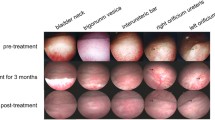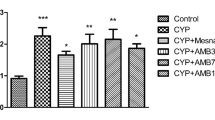Abstract
Purpose
To evaluate the impact of intercellular adhesion molecule 1 (ICAM-1) in hyaluronic acid (HA) therapy in rats model of severe non-bacterial cystitis.
Methods
Cystitis models in Sprague–Dawley female rats were produced by combination of intraperitoneal cyclophosphamide (CYP) with intravesical protamine/lipopolysaccharide (PS/LPS). HA or heparin (0.5 ml) was introduced intravesically to rats’ bladders followed PS/LPS. Bladder tissue was prepared for histology including mast cell presence and measurement of ICAM-1, tumor necrosis factor (TNF)-α, and interleukin 6 (IL-6).
Results
Cystitis model using intraperitoneal CYP and intravesical SP/LPS showed serious inflammation, higher mast cell count with elevated ICAM-1, TNF-α, and IL-6 levels. After intravesical heparin or HA treatment, incidence of grades 3–4 bladder inflammation and tissue ICAM-1 level were only significantly lower in HA group (P = 0.017, P = 0.021, respectively), but not in heparin group (P = 0.12, P = 0.798, respectively). Remarkably lower level of TNF-α (P = 0.003) and ICAM-1 (P = 0.006) was detected in HA-treated rats compared with heparin-treated rats. Inflammation grade and ICAM-1 level had strong correlation (P < 0.001). IL-6 level after HA or heparin instillation had no difference.
Conclusions
Intravesical administration of HA decreased the severity of bladder inflammation, mast cell presence, and levels of ICAM-1 and TNF-α in a rat model of severe non-bacterial cystitis; its effect was more obvious than that of heparin. Reduction of ICAM-1 may play a role in the anti-inflammatory effect of HA.

Similar content being viewed by others
References
Berry SH, Bogart LM, Pham C, Liu K, Nyberg L, Stoto M, Suttorp M, Clemens JQ (2010) Development, validation and testing of an epidemiological case definition of interstitial cystitis/painful bladder syndrome. J Urol 183:1848–1852
Moldwin RM, Sant GR (2002) Interstitial cystitis: a pathophysiology and treatment update. Clin Obstet Gynecol 45:259–272
Riedl CR, Engelhardt PF, Daha KL, Morakis N, Pflüger H (2008) Hyaluronan treatment of interstitial cystitis/painful bladder syndrome. Int Urogynecol J 19:717–721
Ahmad I, Sarath KN, Meddings RN (2008) Sequential hydrodistention and intravesical instillation of hyaluronic acid under general anaesthesia for treatment of refractory interstitial cystitis: a pilot study. Int Urogynecol J 19:543–546
Nickel JC, Egerdie B, Downey J, Singh R, Skehan A, Carr L, Irvine-Bird K (2009) A real-life multicentre clinical practice study to evaluate the efficacy and safety of intravesical chondroitin sulphate for the treatment of interstitial cystitis. BJU Int 103:56–60
Shao Y, Shen ZJ, Rui WB, Zhou WL (2010). Intravesical instillation of hyaluronic acid prolonged the effect of bladder hydrodistention in patients with severe interstitial cystitis. Urology 75:547–550 (author reply 551)
Cox PJ (1979) Cyclophosphamide cystitis—identification of acrolein as the causative agent. Biochem Pharmacol 28:2045–2049
Lanteri-Minet M, Bon K, de Pommery J, Michiels JF, Menétrey D (1995) Cyclophosphamide cystitis as a model of visceral pain in rats: model elaboration and spinal structures involved as revealed by the expression of c-Fos and Krox-24 proteins. Exp Brain Res 105:220–232
Jerde TJ, Bjorling DE, Steinberg H, Warner T, Saban R (2000) Determination of mouse bladder inflammatory response to E. coli lipopolysaccharide. Urol Res 28:269–273
Boucher W, Stern JM, Kotsinyan V, Kempuraj D, Papaliodis D, Cohen MS, Theoharides TC (2008) Intravesical nanocrystalline silver decreases experimental bladder inflammation. J Urol 179:1598–1602
Liu W, Evanoff DP, Chen X, Luo Y (2007) Urinary bladder epithelium antigen induces CD8+ T cell tolerance, activation, and autoimmune response. J Immunol 178:539–546
Cook EB, Stahl JL, Miller ST, Gern JE, Sukow KA, Graziano FM, Barney NP (1998) Isolation of human conjunctival mast cells and epithelial cells: tumor necrosis factor from mast cells affects intercellular adhesion molecule 1 expression on epithelial cells. Invest Ophthalmol Vis Sci 39:336–343
Liebert M, Wedemeyer G, Stein JA, Washington R Jr, Faerber G, Flint A, Grossman HB (1993) Evidence for urothelial cell activation in interstitial cystitis. J Urol 149:470–475
Leppilahti M, Hellström P, Tammela TL (2002) Effect of diagnostic hydrodistension and four intravesical hyaluronic acid instillations on bladder ICAM-1 intensity and association of ICAM-1 intensity with clinical response in patients with interstitial cystitis. Urology 60:46–51
Bona K, Lantéri-Mineta M, Menétreya D, Berkley KJ (1997) Sex, time-of-day and estrous variations in behavioral and bladder histological consequences of cyclophosphamide-induced cystitis in rats. Pain 73:423–429
Soler R, Bruschini H, Truzzi JC et al (2008) Urinary glycosaminoglycans excretion and the effect of dimethyl sulfoxide in an experimental model of non-bacterial cystitis. Int Braz J Urol 34:503–511
Smaldone MC, Vodovotz Y, Tyagi V, Barclay D, Philips BJ, Yoshimura N, Chancellor MB, Tyagi P (2009) Multiplex analysis of urinary cytokine levels in a rat model of cyclophosphamide-induced cystitis. Urology 73:421–426
Springer TA (1994) Traffic signals for lymphocyte recirculation and leukocyte emigration: the multistep paradigm. Cell 76:301–314
McCourt PA, Ek B, Forsberg N, Gustafson S (1994) Intercellular adhesion molecule-1 is a cell surface receptor for hyaluronan. J Biol Chem 269:30081–30084
Dustin ML, Rothlein R, Bhan AK, Dinarello CA, Springer TA (1986) Induction by IL-1 and interferon-γ tissue distribution, biochemistry, and function of a natural adherence molecule (ICAM-1). J Immunol 137:245–254
Sato H, Takahashi T, Ide H (1988) Antioxidant activity of synovial fluid, hyaluronic acid and two sub-components of hyaluronic acid: synovial fluid scavenging affect is enhanced in rheumatoid arthritis patients. Arthr Rheum 31:63–71
Balasz EA, Denlinger JL (1984) The role of hyaluronic acid in arthritis and its therapeutic use. In: Peyron JG (ed) Osteoarthritis. Current clinical and fundamental problems. Geigy, Basel, pp 165–168
Gustafson S, Björkman T, Forsberg N, Lind T, Wikström T, Lidholt K (1995) Accessible hyaluronan receptors identical to ICAM-1 in mouse mast-cell tumors. Glycoconj J 12:350–355
Green M, Filippou A, Sant G, Theoharides TC (2004) Expression of intercellular adhesion molecules in the bladder of patients with interstitial cystitis. Urology 63:688–693
Sant GR, Kempuraj D, Marchand JE, Theoharides TC (2007) The mast cell in interstitial cystitis: role in pathophysiology and pathogenesis. Urology 69:34–40
Larsen MS, Mortensen S, Nordling J, Horn T (2008) Quantifying mast cells in bladder pain syndrome by immunohistochemical analysis. BJU Int 102:204–207
Theoharides TC, Sant GR (1997) The mast cell as a neuroimmunoendocrine effector in interstitial cystitis. In: Sant GR (ed) Interstitial cystitis. Lippincott-Raven, Philadelphia, pp 101–108
Welker P, Grabbe J, Grützkau A, Henz BM (1998) Effects of nerve growth factor (NGF) and other fibroblast-derived growth factors on immature human mast cells (HMC-1). Immunology 94:310–317
Boucher WS, Letourneau R, Huang M, Kempuraj D, Green M, Sant GR, Theoharides TC (2002) Intravesical sodium hyaluronate inhibits the rat urinary mast cell mediator increase triggered by acute immobilization stress. J Urol 167:380–384
Hauser PJ, Buethe DA, Califano J et al (2009) Restoring barrier function to acid damaged bladder by intravesical chondroitin sulfate. J Urol 182:2477–2482
Acknowledgments
The authors express their great thanks to Dr. Yi-fen CUI and Dr. Feng-ying LI for their splendid work in pathological examination and cytokine measurement.
Conflict of interest
The authors declare that they have no conflict of interest or financial disclosure.
Author information
Authors and Affiliations
Corresponding author
Rights and permissions
About this article
Cite this article
Shao, Y., Lu, Gl., Shen, ZJ. et al. Reduction of intercellular adhesion molecule 1 may play a role in anti-inflammatory effect of hyaluronic acid in a rat model of severe non-bacterial cystitis. World J Urol 31, 535–540 (2013). https://doi.org/10.1007/s00345-012-0839-8
Received:
Accepted:
Published:
Issue Date:
DOI: https://doi.org/10.1007/s00345-012-0839-8




